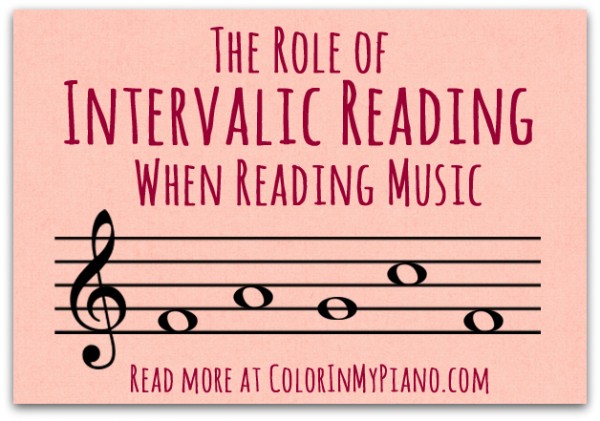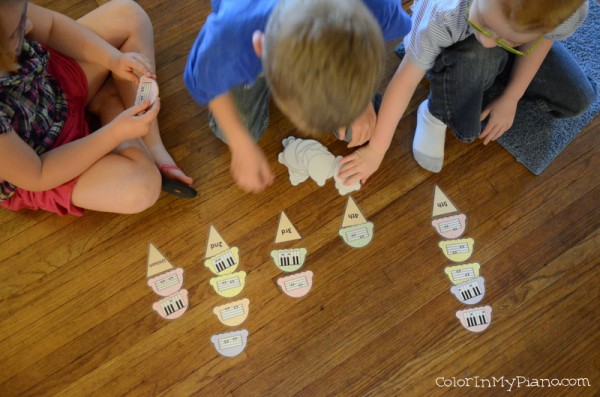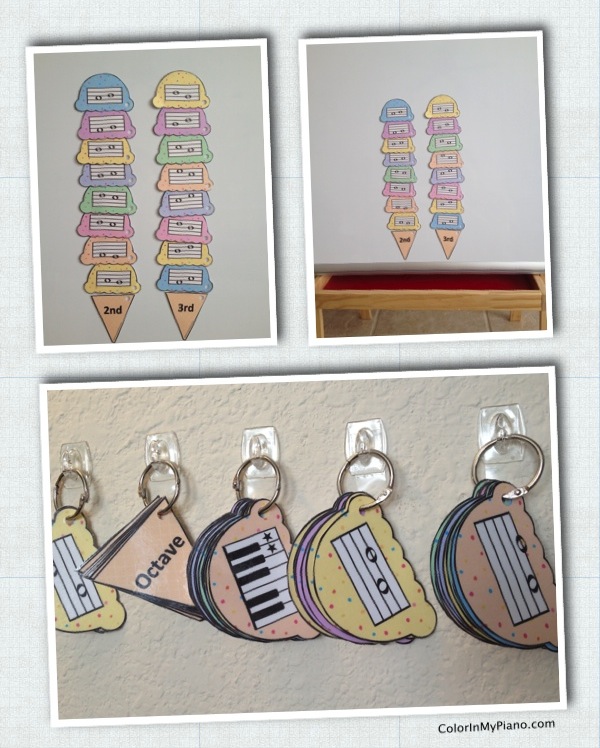A few weeks ago, I added a new game to my Shop called the Ice Cream Interval game. In that post, I briefly mentioned the importance of being able to read intervalically when reading music and I’d like to discuss this further today.

While it is important for students to be able to identify the names of notes quickly, it is equally important for them to read intervals as early as possible in their studies. While I am a big believer in drilling note-naming flashcards, I am an even bigger believer in drilling intervals.
Why Is Intervalic Reading Important?
As an analogy: Think of a concert pianist playing an advanced piece of repertoire. As they play, do they have the letter names of all those notes flying through their minds?
Of course not. It’s far too much to think about. It is much easier for the brain to read intervals — distances between notes — to which the fingers can respond to instantly. They are probably also thinking about the key of the piece and the chords they are playing.
Using this analogy, and it is not difficult to understand the limitation of reading music by only note-identification. The sooner students become fluent at seeing intervals (and chords, later on), the better sight-readers they will become.
Teaching Intervalic Reading
Piano pedagogy textbooks discuss “intervalic reading” as a reading approach utilized by certain piano method books (as opposed to the “Middle C” reading approach or the “Eclectic” reading approach). However, you do not need a specifically “intervalic” method book in order to teach your students to read well intervalically.
When the staff is first introduced to the student, they learn that notes are either line notes or space notes. I like to augment the method book’s theory assignment at this point with my own worksheet, appropriately called the Line & Space Notes Worksheet. Fun & Learn Music also has some great line versus spaces worksheets, too.
Then, as soon as students have learned their first few notes on the staff, it should be brought to their attention that when they play “steps” on the piano keyboard, the notes on the staff alternate between line notes and space notes. And when they play “skips” on the piano, the notes on the staff go from line-to-line or space-to-space. (It’s helpful when teaching to begin by discussing the sound, then discussing how it looks on the keyboard, and lastly talking about the notation. Music notation makes much more sense when you first discuss the need for the notation.)
I like to quiz students on intervals using my DIY music whiteboard. I start by drawing intervals on the staff and asking them to verbally identify them as “step,” “skip,” or “repeated note.” If they seem to be guessing on the answers, I will ask, “How do you know?” before I confirm their answer as correct or incorrect. The student should be looking for whether the notes alternative between line and space notes or whether the notes go line-line or space-space.
To test their understanding further, I use another activity: I draw a single note on the whiteboard staff and ask the student to draw a second note that would be up/down a step/skip.
Later on, the student will learn the interval of the fourth and the fifth. At this point, the terminology usually changes from “repeated note,” “step,” and “skip” to unison, second, and third. When introducing the fourth and fifth, it is important once again to point out that fourths alternate from line note to space note (much like seconds do), and fifths go line-line or space-space (much like thirds and repeated notes do). The goal, once again, is for the student to recognize the interval upon sight, without resorting to identifying the two note-names first and without “counting” between the notes to identify the interval. The only time you will ever hear me say, “No counting!” to a student is when they are identifying intervals or playing the Ice Cream Interval game! 😉

Teaching the intervals of 6th, 7th, and octave should be done in a similar manner.
There are a couple of free interval worksheets available on the Printables > Worksheet page. You can also find some great interval worksheets at Fun & Learn Music. I send supplemental worksheets home with students whenever I feel they could benefit from extra practice with a particular concept.
The “Interval Talk”
Teaching students to read intervallically can be done through the above strategies, but it can also be discussed openly with the student when discussing effectively sight-reading strategies. Reading intervalically is more than a skill: it is a conscious mental shift.
I find that the “interval talk” is particularly important for adult beginner students at some point during their studies. Adult beginners sometimes do not want to advance in their method book because they think they should first become more fluent with the note-names they have already learned. While it may be true that they need on-going practice with note-naming, it’s important for them to realize that it is not the goal to have the name of every note going through their mind as they play a piece. They should understand that reading intervalically is more than okay!
The analogy of the concert pianist described at the beginning of this article is one that any student can understand. I like to follow-up by asking students to think about what percentage of the time should they be reading intervalically as they play, and what percentage of the time they should be reading note-names. It is both interesting and revealing to hear their responses! My opinion is that music reading is at least 80% interval reading and only 20% note identification.
Students may be completely fluent with identifying intervals, but they may need encouragement and reminders to actually utilize interval reading in-the-moment when sight-reading. I like to encourage students to imagine a melody as a string on the page and that they should try to follow the line horizontally with their eyes as much as possible, looking for those steps and skips. In particular, students need to be encouraged to read intervals across barlines, and from one line on the page down to the next. Sometimes, before sight-reading a piece of music, I will ask the student to find and circle all the skips (or fourths, or whatever) in their piece.
Just as with note-identification, students may need plenty of interval drilling throughout the stages of their piano study. Any student who struggles with music reading should be tested on their ability to identify line/space notes and steps/skips in their music. A sure sign that a student is reading mostly by note-name instead of by interval is when the student hesitates before or does not want to play a note that they cannot immediately identify by letter name.
Closing Thoughts
To sum things up: Should students be able to identify any note they play? Yes. Should they necessarily be identifying every note they play as they sight-read? A resounding no! 🙂



Thanks for this! I fully agree but never could put it into words 🙂
Great read! i have been using your ice-cream cut-outs with my students. They are working very well. My grandkids find them on the piano and start sorting when they come over, as well. Thanks!
Thanks, Gabriele. I’m glad the Ice Cream Interval cards are working well for your students, and for your grandkids, too! 😉
absolutely agree with this… great article!
So important to learn intervals along with note names….especially with keyboard instruments when you’re reading many notes at the same time. I have found this with students who have studied an instrument like flute, it’s easy for them to feel overwhelmed when transitioning to keyboard instruments, especially when they have never been interval trained. Excellent article!!
Hi! Thank you for this entire website! I am teaching my sons piano right now and appreciate the extra ideas. I am a teacher, a choir member, and a BIT of a pianist, but definitely not a piano teacher. Many thanks to Piano Adventures for guiding me along, and I am very excited to add the ideas here. I will use them until we are able to enroll our kids in lessons (maybe about a year away)!
Thanks for stopping by, Lindsey! I’m glad you found some articles to read and I’m honored if they prove helpful in any way! 🙂
Great review of some ways to teach intervalic reading. I too incorporate reading and recognizing intervals in my piano lessons and find that it really helps students in reading new music.
Great blog- so happy to find it!
Hi Joy,
I recently discorved your website and finds its very informative and helpful. I just want to say thank you for your knowledge and insight.
Warren.
I just discussed this EXACT concept with a new teen student as he was attempting to learn a new church hymn. It was our second lesson. He told me he didn’t know the bottom bass notes as well. I asked him how comfortable be was reading intervals and he responded that he is very comfortable with intervals, so I told him to just identify the note he knows from the higher tenor note, and play the interval he sees and he’ll automatically have the right bass note (so long as he amounts for the key signature too!). This has been bothering me with some of my younger students, but I couldn’t put my finger on it quite as eloquently as you did in this post. Thank you for making it so clear!
Thank you Joy. My head now hurts. I had wondered what intervals were all about, I can now make good use of them.
An extension, to address a scale other than C, would help firm up the knowledge.
Gr8, keep it up. You’re a practical teacher, one who knows and not just talk. This happens to come to me while i was teaching some school kids and i just wanted to be sure before i go deep into it and i came across your resounding affirmation on this topic. Thanks